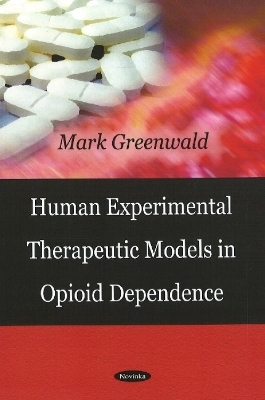
Human Experimental Therapeutic Models in Opioid Dependence
Seiten
2008
Nova Science Publishers Inc (Verlag)
978-1-60456-807-3 (ISBN)
Nova Science Publishers Inc (Verlag)
978-1-60456-807-3 (ISBN)
Discusses developments in human experimental models relating to the treatment of opioid dependence. This book reviews evidence concerning individual differences identified in these models.
This book selectively discusses recent advances in human experimental models relating to the treatment of opioid dependence. The author critically reviewed three independent lines of research conducted during the past decade with heroin-dependent volunteers. One research strategy involves studying the -opioid receptor ( OR), which is the molecular target for the reinforcing and physical dependence producing effects of heroin-like drugs. This has been accomplished by varying medication dose conditions, measuring the availability of brain -receptors in vivo and plasma pharmacokinetics, then correlating these biological concentration measures with clinically relevant endpoints including opioid withdrawal symptoms, heroin craving, and blockade of the euphoric and respiratory depressant effects of -agonist challenges. These studies provide an initial benchmark for estimating OR occupancy or plasma concentration requirements for effective pharmacotherapy. A second research strategy determines the conditions under which -agonist medications function as reinforcers, and the ability of medication dose and the availability of non-drug alternative reinforcement to attenuate opioid choice. Taken together, these studies provide information relevant to the ability of the medication to stimulate adherence and reduce drug demand. A third research strategy seeks to determine whether non-opioid medications can attenuate the naloxone-precipitated (i.e. withdrawal related) discriminative stimulus, subjective and/or physiological effects in opioid-maintained individuals. These studies aim to identify compounds that may be safe and effective adjuncts during opioid detoxification and, potentially, anti-relapse agents. Evidence is also reviewed concerning individual differences identified in these models. Implications of these findings for clinical treatment are also discussed.
This book selectively discusses recent advances in human experimental models relating to the treatment of opioid dependence. The author critically reviewed three independent lines of research conducted during the past decade with heroin-dependent volunteers. One research strategy involves studying the -opioid receptor ( OR), which is the molecular target for the reinforcing and physical dependence producing effects of heroin-like drugs. This has been accomplished by varying medication dose conditions, measuring the availability of brain -receptors in vivo and plasma pharmacokinetics, then correlating these biological concentration measures with clinically relevant endpoints including opioid withdrawal symptoms, heroin craving, and blockade of the euphoric and respiratory depressant effects of -agonist challenges. These studies provide an initial benchmark for estimating OR occupancy or plasma concentration requirements for effective pharmacotherapy. A second research strategy determines the conditions under which -agonist medications function as reinforcers, and the ability of medication dose and the availability of non-drug alternative reinforcement to attenuate opioid choice. Taken together, these studies provide information relevant to the ability of the medication to stimulate adherence and reduce drug demand. A third research strategy seeks to determine whether non-opioid medications can attenuate the naloxone-precipitated (i.e. withdrawal related) discriminative stimulus, subjective and/or physiological effects in opioid-maintained individuals. These studies aim to identify compounds that may be safe and effective adjuncts during opioid detoxification and, potentially, anti-relapse agents. Evidence is also reviewed concerning individual differences identified in these models. Implications of these findings for clinical treatment are also discussed.
Preface; Introduction; Studies Correlating Biological Concentrations and Clinical Effects; Studies of Opioid Choice; Evaluations of Medications for Attenuating Physical Dependence; Conclusion; Index.
| Erscheint lt. Verlag | 1.12.2008 |
|---|---|
| Zusatzinfo | Illustrations |
| Verlagsort | New York |
| Sprache | englisch |
| Maße | 230 x 155 mm |
| Gewicht | 180 g |
| Themenwelt | Medizin / Pharmazie ► Medizinische Fachgebiete ► Suchtkrankheiten |
| Studium ► 2. Studienabschnitt (Klinik) ► Pharmakologie / Toxikologie | |
| ISBN-10 | 1-60456-807-0 / 1604568070 |
| ISBN-13 | 978-1-60456-807-3 / 9781604568073 |
| Zustand | Neuware |
| Haben Sie eine Frage zum Produkt? |
Mehr entdecken
aus dem Bereich
aus dem Bereich
Buch | Hardcover (2024)
Thomas Karow (Verlag)
CHF 79,95
Buch | Hardcover (2022)
Urban & Fischer in Elsevier (Verlag)
CHF 138,60


